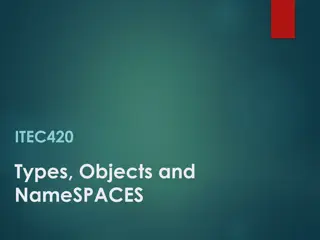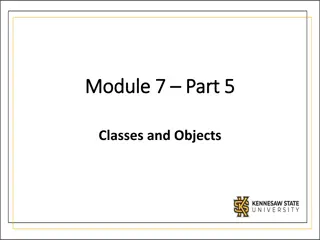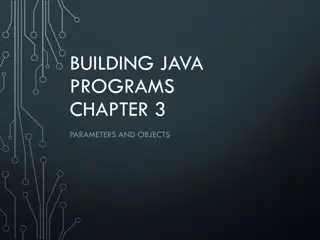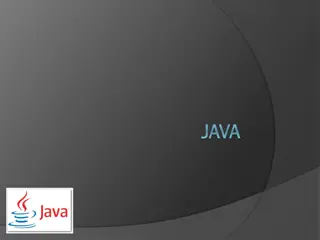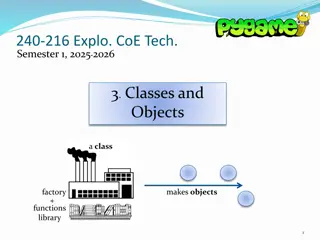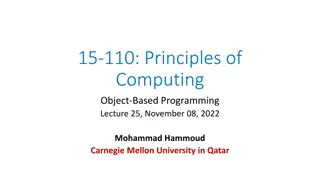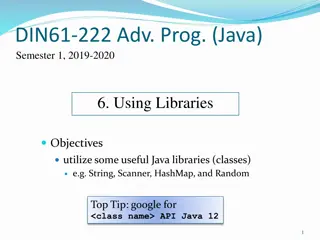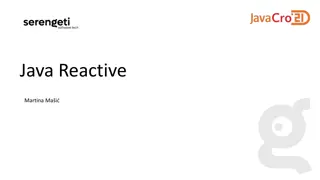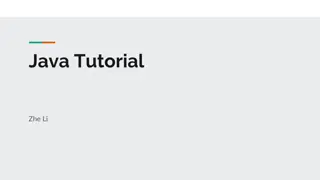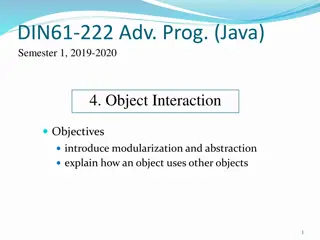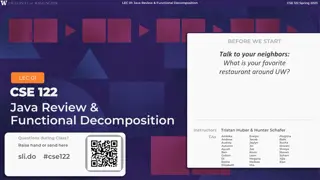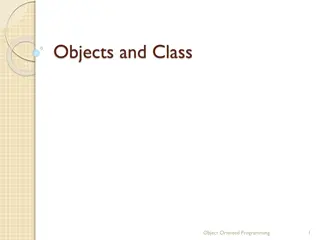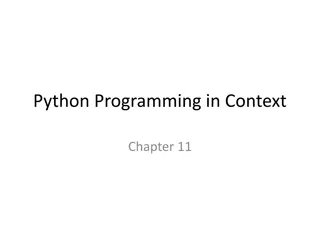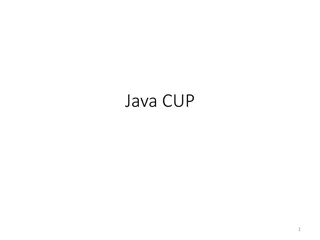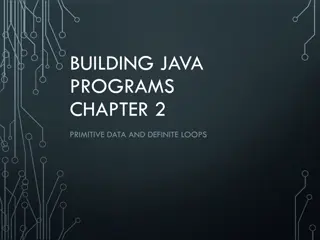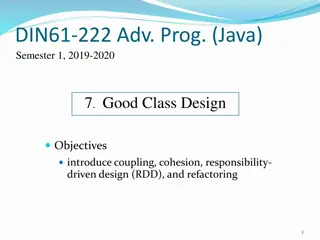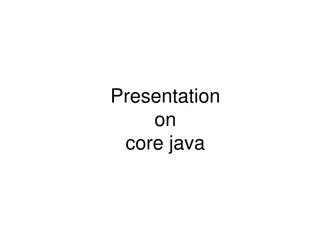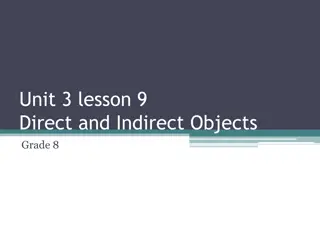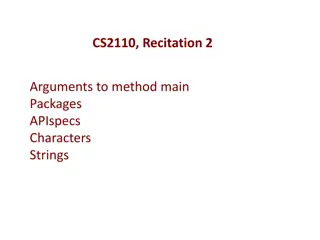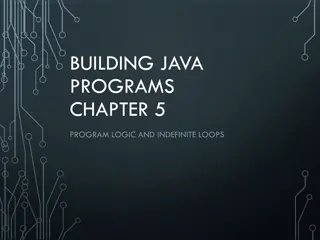Understanding Classes and Objects in Java Programming
Explore the fundamentals of Java classes and objects, including defining classes, instance variables, methods, constructors, accessors, mutators, static vs instance members, creating and calling methods, encapsulation, object-oriented design principles, and designing custom classes for specific tasks like managing ice cream orders.
Download Presentation

Please find below an Image/Link to download the presentation.
The content on the website is provided AS IS for your information and personal use only. It may not be sold, licensed, or shared on other websites without obtaining consent from the author. Download presentation by click this link. If you encounter any issues during the download, it is possible that the publisher has removed the file from their server.
E N D
Presentation Transcript
JAVA Classes
Objectives Be able to define new classes Be able to define appropriate instance variables Be able to define the usual methods of a class Constructors Accessors Mutators Other Be able to distinguish between static and instance variables and methods Be able to create and call static methods Be able to create and call instance methods
3 Classes Classes encapsulate object types. In object-centered design we Reuse old classes where possible Build new classes when necessary Each new class that we design and build should have a coherent set of: Knowledge Responsibilities
Ice Cream Orders Suppose you were writing a program for use at an ice cream shop. The program needs to help track what orders are given and when they have been fulfilled. What are the necessary Data? Number of scoops Flavor Order fulfilled (true or false) Operations? Create new order Change fulfilled status Compute cost
5 Classes and Objects Classes describe sets of similar objects by specifying their: Attributes Behaviors Each object has its own copies of the attribute values.
6 Using Classes When you use a class object: The calling program doesn t know: How to initialize the object s data How to implement the object s methods The object itself is responsible for these things. The calling program accesses them by calling predefined methods.
7 /** DRIVER PROGRAM * ... appropriate documentation ... */ package c09classes.icecream; public class IceCreamConsole{ //Create a default order IceCreamOrder firstOrder = new IceCreamOrder(); System.out.println(firstOrder); //Change the number of scoops firstOrder.setScoops(3); System.out.println(firstOrder); } //Print out how much the order costs System.out.println( Collect: + firstOrder.getCost());
8 Designing Classes When we want to work with objects not supported by existing types, we must design a new class. The key design issues here are: What classes do we need? What goes in them (and what doesn t)?
9 Information Hiding When we design a class we distinguish: the external interface to a class; the internal implementation of the class. The principle of information hiding dictates that a class designer: provide public views of those things that a class user really needs to know; hide all other details by making them private.
10 Design using Perspectives Use an external perspective to specify the public interface to a class. Use an internal perspective to specify the internals of the class design.
11 Implementing Classes Implementing the class attributes Implementing the class methods: Constructors Default-value constructor Explicit-value constructor Accessors Mutators Other Methods Copy Constructors
12 Class Attributes IceCreamOrder objects will certainly have to encapsulate their own: # of scoops; flavor; fulfilled status These will be stored as instance variables, which means that each IceCreamOrder object will have its own versions of these values.
13 Implementing Class Attributes class IceCreamOrder{ private int myScoops; // number of scoops private String myFlavor; // flavor of ice cream private boolean myStatus; // order completion // other class stuff here }
14 Default-Value Constructor External View (in the driver): IceCreamOrder order1 = new IceCreamOrder(); Internal View (in the class): /** * Construct a new IceCreamOrder with default values */ public IceCreamOrder() { myScoops = 1; myFlavor = Vanilla ; myStatus = false; }
15 Constructors as Methods Constructors are like methods except that: They have no return type They are given the same name as the class They are invoked with new: IceCreamOrder order = new IceCreamOrder(); Constructors initialize instance variables within the limits set by the invariants. Constructor methods are often overloaded.
16 Class Invariants Objects must maintain the integrity of their internal data. /** * Indicate whether or not the number of scoops is valid. * @param scoops the value to check * @return true if valid, false otherwise */ private boolean isValidScoops(int scoops) { if (scoops < 1) { return false; } return true; }
17 Explicit-Value Constructor External View: IceCreamOrder order1 = new IceCreamOrder(2, Superman , false); Internal View: /** Construct a new IceCreamOrder * @param scoops the number of scoops * @param flavor the ice cream flavor * @param status the order status */ public IceCreamOrder(int scoops, String flavor, boolean status){ if(isValidScoops (scoops)){ myScoops = scoops; } else{ System.err.println( Invalid number of scoops: + scoops); System.exit(-1); } myFlavor = flavor; myStatus = status; }
18 Accessor Methods /** @return my number of scoops */ public int getScoops() { return myScoops; } /** @return my flavor */ public String getFlavor() { return myFlavor; } /** @return my order status */ public boolean getStatus() { return myStatus; }
19 Mutator Methods /** Change my order completion status */ public void setStatus(boolean status) { myStatus = status; } /** Set a new number of scoops for the order * @param scoops non-negative scoops value */ public void setScoops(int scoops) { if (isValidScoops(scoops)){ myScoops = scoops; } else{ System.err.println( Could not change number of scoops to + scoops); System.exit(-1); } }
20 Other Methods /** * Print out the value of the order */ public String toString() { String result = myScoops + scoop(s) of + myFlavor + : ; if (myStatus){ result += Fulfilled ; } else{ result += Unfulfilled ; } return result; }
21 Copy Constructors We can t copy objects as follows: IceCreamOrder order1 = new IceCreamOrder(); IceCreamOrder order2 = order1; This only copies the reference. Thus, we must write copy constructors: IceCreamOrder order1 = new IceCreamOrder(); IceCreamOrder order2 = order1.copy();
22 Copying Objects /** * @return a copy of myself */ public IceCreamOrder copy() { return new IceCreamOrder(myScoops, myFlavor, myStatus); }
23 Instance versus Class Members Java allows data and methods to be associated with either: A particular object, or The class as a whole. Instance members are defined for each object of a class. Class members are marked as static and are shared by all objects of a class. Static methods only reference static data. Static methods can be called without creating an instance of the class.
24 Referencing Members Instance members are referenced using the object identifier. objectIdentifier.memberIdentifier Class members are referenced using the class identifier. ClassIdentifier.memberIdentifier Examples: instance: keyboard.readDouble() class: Math.PI
Class Data Instance data is unique for each object of a class Class data is shared between all objects of a class Marked as static static private static final double PRICE_PER_SCOOP = 1.50; public double getCost() { return myScoops * PRICE_PER_SCOOP; }
26 Object Interaction Sometimes objects must interact with each other. /** * Compares one order to another * @param other * @return whether or not the order is bigger than * some other order */ public boolean isBigger(IceCreamOrder other){ return myScoops > other.getScoops(); }


